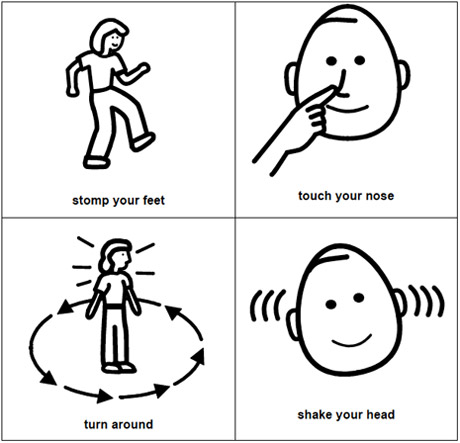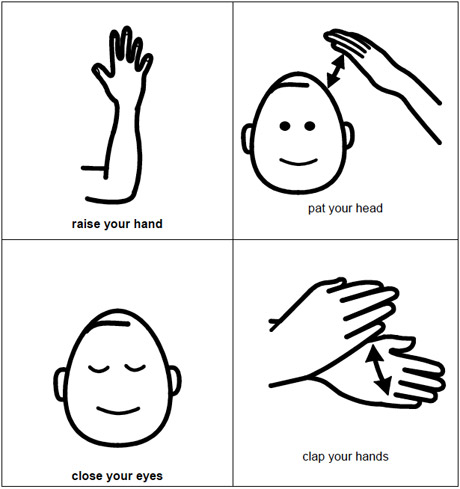This game is a fun and interactive way for children to learn about parts of the body and get some exercise! It can also improve their listening and observation skills.
How to Make
You will need
- Computer and printer
- Pencil
- Ruler
- Scissors
- Glue or a glue gun
- 1 roll of Mactac
- A 27cm by 34 cm piece of Bristol Board
- A thin piece of Velcro approximately 30 cm long.
- Small piece of coloured construction paper.
- 1 brass paper fastener
Steps
- Print out a copy of the Simon Says cards.
- Cut out the cards. Apply Mactac to both sides of each card.
- Create the spinner. Start by drawing an arrow on a small piece of construction paper. Apply Mactac to both sides of the arrow. Using the paper fastener attach the flat end of the arrow to the card that says, ‘Simon Says’.
- To make the game board, use a pencil and ruler to draw nine square grid on the Bristol board.
- Pull the Velcro strip apart. There are now two strips of Velcro.
- Take one strip of Velcro and cut it into ten pieces. Glue one piece to the back of each card.
- Take the remaining strip of Velcro and cut it into ten pieces. Glue one piece to the middle of each square on the game board.
- When the glue dries, the cards can be attached to the game board. Attach the ‘Simon Says’ card with the spinner to the middle square. The remaining cards can be placed wherever you like.
You are ready to play Simon Says!
Hints
- Velcro is often sold as ‘hook and loop tape’ in craft stores.
- You can use ‘instant tack’ instead of Velcro to attach the cards to the board.
- Add new directions by replacing some of the cards on the board with your own hand-drawn ones. For example, “touch your toes”.
How to Play
Instructions are given for two players but more people can be included.
- First player spins the arrow. When the arrow stops he says, “Simon Says” and reads the directions printed on the card the arrow is pointing to. The picture on the card shows players what to do.
- Both players do the action on the card.
- The second player takes a turn.
The game continues until the arrow has landed on each card or each player has had four turns.
Teaching Tips
To start, this game is best played with just you and your child. As he becomes more familiar with it, you can include a sibling or a playmate.
Begin by showing your child the game board and cards. Point to each card and read the directions out loud. For example, “Clap your hands.” Demonstrate the action while repeating the directions. Emphasize the action words and names of body parts. For example, “clap”, “touch”, “shake”, “hands”, and “head”.
Encourage your child to participate by calling his name and repeating the direction. “Billy, clap your hands!” If your child needs to learn the movements, guide him physically. You can do this by standing behind your child and repeating the directions while slowly moving his body. This will help him associate the directions with certain body movements. If your child is uncomfortable with people approaching him from behind, you can guide him face-to-face instead.
Show your child the spinner and how it moves. You can take turns spinning the arrow. When the arrow lands on a card, say “Simon Says,” read the direction out loud, and do the action. With practice, your child will learn to follow the directions by imitating your actions, looking at the card, or listening to the directions.
This game can also be used to develop your child’s language skills by having him say the directions out loud with you. For example, when the arrow lands on a card your child can start by saying “Simon says” and you can finish by reading the direction printed on the card. You can also prompt your child to describe the action on the card by saying, “Simon says…Clap your_________,” while pointing to the card and giving him a chance to complete the sentence. When the sentence has been completed you can do the action together.
Variation 1
Improve your child’s matching skills by playing this simple variation.
How to Make
- Print out 2 copies of the game cards and cut them out.
- Glue one set of cards to the Bristol board and cover with Mactac.
- Take the remaining set and apply Mactac to both sides of each card.
How to Play
- Arrange the deck of cards face down.
- One player takes the top card from the deck and places it (face up) on top of the matching picture on the board
- All players do the action on the card.
- The next player takes a turn.
- The game ends when all cards have been matched on the board.
Variation 2
This version of the game is more challenging because it emphasizes listening to what ‘Simon’ says rather then copying ‘Simon’s’ actions. It is often played with a larger group of children.
One person is chosen to be ‘Simon’. ‘Simon’ stands in front of the group and says a direction out loud while doing an action. Each person in the group must do what ‘Simon’ says. This can be tricky as ‘Simon’ will sometimes do one thing while saying another. For example, ‘Simon’ may shake his head while telling the group to, “touch your nose.” People who do not do listen to ‘Simon’ and do what he says are out of the game. The winner is the person left at the end.



Made with “Boardmaker” and the Picture Communication Symbols © 1981-2002. Mayer-Johnson, Inc. P.O. Box 1579, Solano Beach CA 92075-75-79 U.S.A
